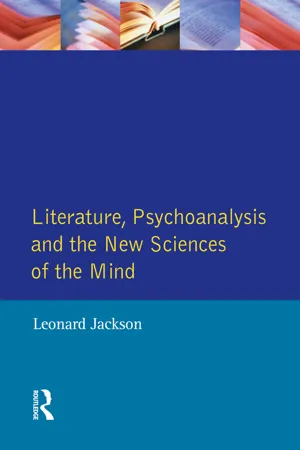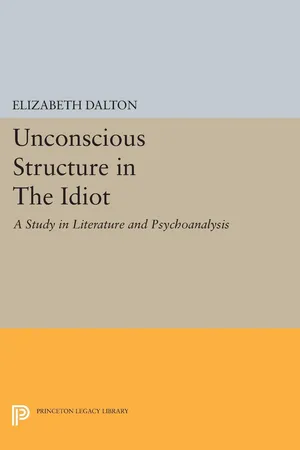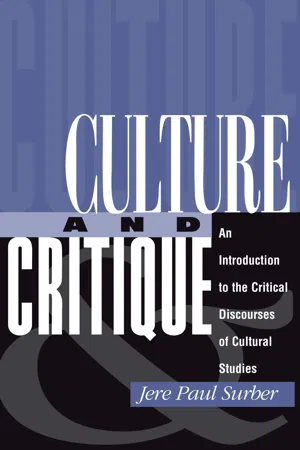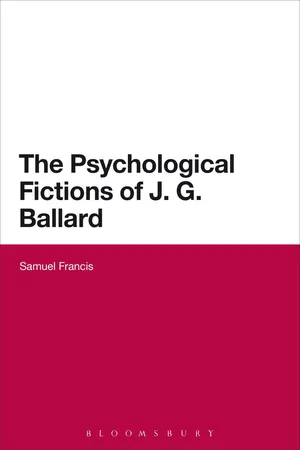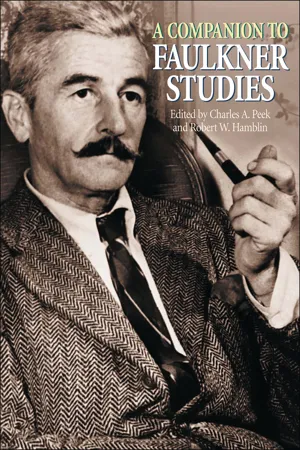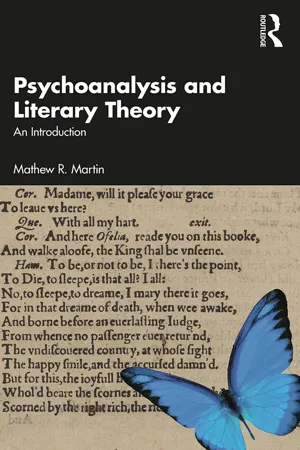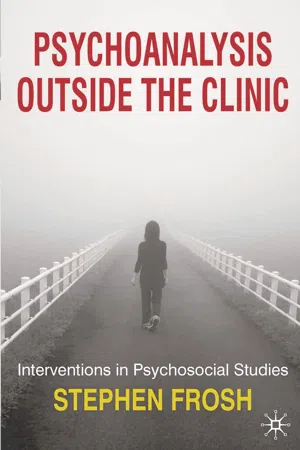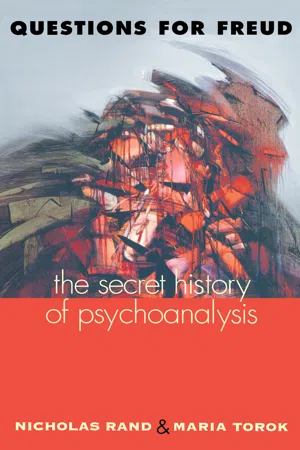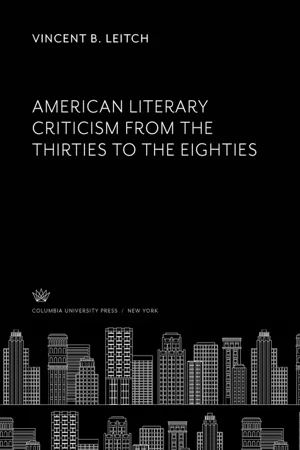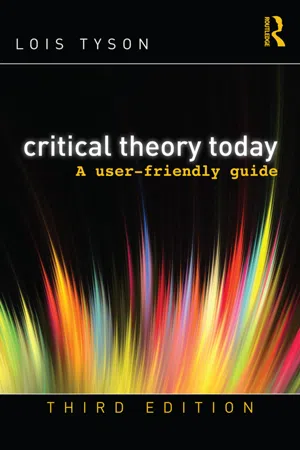Literature
Freudian Criticism
Freudian criticism is a literary theory that applies Sigmund Freud's psychoanalytic principles to the analysis of literature. It focuses on exploring the unconscious motivations and desires of characters, as well as the psychological elements of the author's work. This approach often delves into symbolism, dreams, and the influence of the subconscious mind on the creation and interpretation of literary texts.
Written by Perlego with AI-assistance
Related key terms
1 of 5
12 Key excerpts on "Freudian Criticism"
- Leonard Jackson(Author)
- 2014(Publication Date)
- Routledge(Publisher)
5 – but the enterprise is not a nonsensical one. Nor is it entirely nonsensical to do what is now most fashionable – to go one stage further and treat literary criticism as the master discourse, with which one interrogates and analyses the Freudian texts.But there was a time between – stretching, let us say, from about 1910 to 1970 – when Freudian theory was defensible as the best scientific theory of the full complexities of the human mind that we had; and many of the analyses of the mind developed in that period have not been superseded by anything in modern cognitive theory. I am thinking in particular of analyses of types of ego defence. In that time it seemed possible to treat Freudian theory as offering something like a scientific explanation of the way literature works, including the way it is created, and the way it is read; and to treat Freudian literary criticism as an application of a genuinely independent science.Five applications of Freudian theory to literature
Classical Freudian theory appears to be relevant to the theory of literature in at least five ways. It suggests a theory of literary creation, on the lines of dream and symptom formation, in which underlying fantasies are combined with daily experience and with material from the literary tradition, by processes of condensation, displacement, the use of concrete imagery, and the use of pre-existing symbols. This in turn suggests a process of literary interpretation, applied to texts, which attempts to get back to the underlying unconscious material. The two processes taken together suggest a theory of writing and reader-response, which tells us a great deal about how literature functions and what it is for – how it deals with traumatic material, for example. It also provides a theory of universal human nature, in its account of the structure of the mind and the contents of the unconscious; and of the vagaries of individual character, in its extensive library of case studies. This may be the full range of possibilities for explanatory theory. Modern post-Lacanians don’t generally offer new literary applications of Freudian theory; as we shall see in Chapter 7- eBook - PDF
Literary Theory
An Introduction
- Terry Eagleton(Author)
- 2011(Publication Date)
- Wiley-Blackwell(Publisher)
To do this, it focuses in particular on what have been called ‘symptomatic’ places in the dream-text – distortions, ambiguities, absence and elisions which may provide a specially valuable mode of access to the ‘latent content’, or unconscious drives, which have gone into its making. Literary criticism, as we saw in the case of Lawrence’s novel, can do something similar: by attending to what may seem like evasions, ambivalences and points of intensity in the narrative – words which do not get spoken, words which are spoken with unusual frequency, doublings and slidings of language – it can begin to probe through the layers of secondary revision and expose some-thing of the ‘sub-text’ which, like an unconscious wish, the work both conceals and reveals. It can attend, in other words, not only to what the text says, but to how it works . 6 Some Freudian literary criticism has pursued this project to a certain extent. In his The Dynamics of Literary Response (1968), the American critic Norman N. Holland, following Freud, sees works of literature as setting in motion in the reader an interplay of unconscious fantasies and conscious defences against them. The work is enjoyable because by devious formal means it transforms our deepest anxieties and desires into socially acceptable meanings. If it did not ‘soften’ these desires by its form and language, allowing us sufficient mastery of and defence against them, it would prove unacceptable; but so would it if it merely reinforced our repressions. This, in effect, is little more than a restatement in Freudian guise of the old Romantic opposition between turbulent content and harmonizing form. Literary form for the American critic Simon Lesser, in his Fiction and the Unconscious (1957), has a ‘reassuring influence’, combating anxiety and cel-ebrating our commitment to life, love and order. Through it, according to Lesser, we ‘pay homage to the superego’. - eBook - PDF
Unconscious Structure in The Idiot
A Study in Literature and Psychoanalysis
- Elizabeth Dalton(Author)
- 2015(Publication Date)
- Princeton University Press(Publisher)
Psychoanalysis helps us to understand the tension of this dialectic within which creation takes place, by reminding us that literature is rooted in the gut and the genitals as well as in the brain, in the infantile and regressive aspects of psychic function as well as in the maturely integrated ego, in delusion and dream as well as in history, reality, and ra- tionality. In refusing to wall off a separate place for art and spirit, psychoanalysis insists on the continuity of all human experience. (Continuity, of course, does not mean equiva- 20 PART 1. THEORY lence or identity.) In this insistence that nothing human be regarded as alien, psychoanalytic method is bound to offend the squeamish. But in tracing the connections between literary art and primitive physical and psychic functions, and in suggesting that we may understand the literary text more fully by studying the expression of unconscious meaning in dreams, fantasies, and symptoms, psychoanalytic criticism does not demean the literary work. On the contrary, psychoanalysis enlarges and enriches the significance of literature by discovering, scrawled on the walls of the darkest and inmost caves of the mind, the pre- historic images and scripts that are the rudiments of art, and that implicate it absolutely in all human life. III. REPRESSION, THE UNCONSCIOUS, AND THE STRUCTURE OF THE LITERARY WORK Psychoanalysis begins from the premise that the outward shape and the explicit content of an expressive "text"— dream, symptom, or work of literature—do not exhaust its significance. Most literary criticism is based on the same assumption—that the text has a meaning that cannot be communicated directly, that must be evoked obliquely through imitation, symbol, allusion, and all the devices and stratagems of literature. - eBook - ePub
Culture And Critique
An Introduction To The Critical Discourses Of Cultural Studies
- Jere Paul Surber(Author)
- 2018(Publication Date)
- Routledge(Publisher)
To complete our survey of the critical discourse of psychoanalysis, brief note must be taken of its widespread appropriation by other creative and critical practices. Like all of the critical discourses that we are considering, psychoanalysis offered a new theoretical framework and vocabulary in which to pose novel questions and explore a range of alternative responses to them. Even in Freud’s own lifetime, some of the basic ideas and themes of psychoanalysis came to influence not only other critical discourses concerned with culture (such as Marxism and the Frankfurt School of critical theory) but also many figures directly involved in cultural production. Among the latter can be counted such authors as Thomas Mann, D. H. Lawrence, and James Joyce; visual artists involved in the Dadaist and Surrealist movements, including Max Ernst and Salvador Dali; and composers such as Arnold Schoenberg, Alban Berg, and Richard Strauss, whose operas explicitly drew on key Freudian notions.Literary criticism (and its cousin, media criticism) has employed psychoanalytic insights in particularly productive ways. While few literary or media critics would consider their approach exclusively psychoanalytic, many have drawn on various psychoanalytic ideas in their attempts to interpret the multiple dimensions of cultural texts. In his book Literary Theory: An Introduction (1983), Terry Eagleton provides a helpful classification of approaches to literary works that have employed psychoanalytic insights. There he distinguishes among psychoanalytic interpretations that focus on a work’s author , its contents , its formal construction , and its reader .As we have seen, Freud himself first pointed the way toward reading cultural texts as manifestations of the unconscious psychic conflicts of the author, suggesting that they be approached by analogy to the manifest content of dreams, that is, as products of the author’s daydreams and fantasies. By a more or less straightforward appropriation of Freud, cultural texts can provide ready examples for exploring the psychodynamics of the individual outside the rarefied context of clinical psychoanalysis. From a more critical perspective, such analyses remind us that cultural products are never completely under the control of even the most deliberate author but reveal a complex interplay between unconscious desire and conscious representation that constantly overruns the author’s intentions. For some critics, psychoanalytic approaches to cultural products indeed help us understand their authors better than those individuals understood themselves. The critical writings of Ernest Jones and Harold Bloom provide some of the best known examples of this approach. Perhaps even more interesting from a critical perspective are attempts to psychoanalyze the collective author of commercial productions such as television series, advertisements, film genres, or political campaigns, where collective patterns of repression and neurosis often manifest themselves. - eBook - PDF
- Samuel Francis(Author)
- 2011(Publication Date)
- Continuum(Publisher)
It must also be self- conscious about its engagement with psychology’s (and particularly psychoanalysis’) diffusion within culture more generally, with the ways, for example, in which Freud’s work has become absorbed into the texture of critical theory and of deconstruction, but also with the ways in which concepts such as the unconscious have become part of common cultural assumptions in the contemporary. Psychology’s significance as a paradigm for the interpretation of litera-ture was reflected in the existence of the journal Literature and Psychology , published in Providence, New Jersey, which ran from 1951 until 2004. Of all aspects or strands of psychology, psychoanalysis has occupied the centre stage in the history of literary criticism, and near the end of this period a number of significant critical interventions made forceful cases for the continued relevance of psychoanalysis; these included Linda Ruth Williams’ Critical Desire: Psychoanalysis and the Literary Subject (1995), Sue Vice’s Psychoanalytic Criticism: A Reader (1996), and Elizabeth Wright’s useful survey Psychoanalytic Criticism: A Reappraisal (1998). Psychoanalysis remains an important theoretical corpus in the field of literary and cultural stud-ies, for reasons which are perhaps due partly to the incredible success with which it became disseminated in twentieth century culture, and partly to its The Psychological Fictions of J. G. Ballard 14 strongly interpretative and textual emphasis as a discipline, which makes it highly sympathetic to the practice of criticism. More recently, new critical trends have begun to explore relationships between narrativity and consciousness and to apply the discoveries of cog-nitive psychology to literary study, signalling the enduringly fruitful inter-section of literature’s and psychology’s shared concerns with the human mind and human experience. - eBook - PDF
- Charles Peek, Robert W. Hamblin, Charles Peek, Robert W. Hamblin(Authors)
- 2004(Publication Date)
- Greenwood(Publisher)
8 Psychological Criticism Doreen Fowler With his model of the unconscious mind, Freud laid the groundwork for all psy- choanalytic literary criticism. According to Freud, the mind is a dynamic opera- tion between conscious mental processes and unconscious ones. The unconscious is constituted by repression, the refusal or denial of guilty desires, instincts, thoughts, or impulses. For Freud, repression is "the cornerstone on which the whole structure of psychoanalysis rests" (Standard Edition 14:16). His famous essay "Repression" (1915) sets forth his theory that repressed mate- rial always returns—"repression itself produces substitute formations and symptoms, . . . indications of a return of the repressed" (14:154)—but it returns in disguised forms so as to elude conscious censors. Scrambled and trans- formed, repressed material surfaces in dreams ("the royal road to the uncon- scious" [5:608]), in parapraxes (Freudian slips), in jokes, and in art. Just as the psychoanalyst decodes hidden, outlawed meanings in the analysand's dreams, images, or narrations, so psychoanalytic criticism deciphers veiled, returned meanings in literary texts. For Freud, art enacts the reality of the unconscious mind, if we can only learn to read its submerged or latent content; and, in his classic work "The Interpretation of Dreams," he instructs us in the methods (or "dream-work") by which dreams subvert and distort a meaning that cannot be accepted by the conscious mind. In each of these methods, shifts and substitu- tions take place usually by means of a chain of associations. For Freud, whatever the specific content of repressed material, repression always invokes primary repression, the original psychic trauma that opens up the unconscious and introduces identity formation, particularly male identity. (Freud admits that, "our insight into these developmental processes in girls is 198 A COMPANION TO FAULKNER STUDIES unsatisfactory, incomplete, and vague" [19:179]). - eBook - ePub
Psychoanalysis and Literary Theory
An Introduction
- Mathew R. Martin(Author)
- 2022(Publication Date)
- Routledge(Publisher)
1Freud and Literary Criticism1DOI: 10.4324/9781003219347-2As we saw at the beginning of the introductory chapter, psychoanalysis began with the first piece of psychoanalytic literary criticism, Freud’s interpretation of Sophocles’s Oedipus Rex andShakespeare’s Hamletin light of his childhood memory. Psychoanalysis is “first and foremost an art of interpreting” Freud would later comment in Beyond the Pleasure Principle (1920). As we will see in this chapter, however, the art of psychoanalytic interpretation—psychoanalytic hermeneutics—is challenging: it is challenging in the demands it places on the text or work of art, and its theories and methods challenge many of the key concepts and methods of non-psychoanalytic literary criticism.Oedipus Rex and Hamlet: Mimesis, Tragedy and Catharsis
Freud’s analysis of the Oedipus complex takes us back to some of the oldest concepts in the history of Western literary criticism: mimesis, tragedy and catharsis. In his Poetics, classical Greek philosopher Aristotle (384–322 BCE) defined artistic mimesis as the imitation of “people doing things” (52). These people “must necessarily be either good or bad” (52), Aristotle remarks, and this difference “marks off tragedy from comedy, since the latter aims to represent people as worse, the former as better, than men of the present day” (53). “A tragedy,” he continues, “is a mimesis of a high, complete action” (57). The imitation must be realistic (62), the characters must be noble, and the action or plot must be unified—i.e. it must have a causally connected beginning, middle and end (60–61)—and all other elements of the drama, including character, must be subordinate to it. Significantly, Aristotle argues that “in the particular actions themselves there should be nothing irrational, and if there is it should be outside the tragedy, like that of Sophocles’s Oedipus” (70). Peripeteiai, or reversals of the protagonist’s fortune, brought about by anagnorisis, or a moment of recognition or discovery, and culminating in a scene of pathos “involving destruction or pain” (65) are key elements in the plot of a tragedy, whose ultimate purpose or telos is to provoke the emotions of pity and fear in its audience in order to effect “the catharsis [purging] of such emotions” (57). Having thus defined tragedy as a genre, Aristotle then examines specimens of Greek drama in order to illustrate his definition, and Oedipus is one of his paradigmatic examples. Oedipus himself is precisely the kind of character to create pity and fear in the audience: he is “one who is not pre-eminent in moral virtue, who passes to bad fortune not through vice or wickedness, but because of some piece of ignorance, and who is of high repute and great good fortune” (66). The plot of the play is of the best kind: the irrational is excluded, and the reversal of fortune is brought about by a moment of recognition that is realistic and logical (72). Indeed, the play achieves the cathartic telos of tragedy superlatively, Aristotle declares: it is “so composed that even without seeing the action, a man who just hears what is going on shudders and feels pity because of what happens” (67). Importantly, however, the shudder of pity and fear that the audience experiences is also a spasm of pleasure. “Mimesis - eBook - ePub
Psychoanalysis Outside the Clinic
Interventions in Psychosocial Studies
- Stephen Frosh(Author)
- 2010(Publication Date)
- Bloomsbury Academic(Publisher)
Just as Lacan was led to draw on the work of structural linguistics to explain the functioning of the mind in terms of metaphor and metonymy, so Trilling, writing in a very different tradition, saw the essential literary humanism of Freud as residing in his discovery of mental mechanisms such as displacement and condensation. This was additional to a more general humanistic sympathy that, according to Trilling, Freud had with the great literary traditions, one characterised by openness to suffering and an essentially tragic vision that was without cynicism even when it was characterised by irony. Freud himself is an artist, in this sense, or at least his view of the world has much to offer the artist: ‘the poetic qualities of Freud’s own principles, which are so clearly in the line of the classic tragic realism, suggest that this is a view which does not narrow and simplify the human world for the artist but on the contrary opens and complicates it’ (p.68). There are thus two ways in which Freudian psychoanalysis can contribute to the literary imagination: as a general, tragic vision of human nature out of which a moral system can be welded together; and as a specific, ‘scientific’ approach that shows how the mind itself obeys literary laws, and is thus open to the reception and expression of poetic modes of being. This approach, it might be noted, to some extent reverses the master–slave dynamic of traditional psychoanalytic criticism. This time, it is literature that is being used to make sense of psychoanalysis. It is literature that has the interpretive and technical facility available to it, and psychoanalysis that draws on literary tropes to theorise its own object of study, the mind. On the other hand, what Trilling is pointing to here is an essential sympathy between psychoanalysis and literature that might be used to the advantage of both, without the struggle for dominance that had thitherto characterised the field.Two ‘classic’ accounts of the literary nature of Freudian psychoanalysis are worth noting here. The first is Steven Marcus’ (1975) exploration of the ‘Dora’ case study (Freud, 1905). His title, Freud and Dora: Story, History, Case History, captures the way in which his reading proceeds, as a highly sympathetic rendering of it as if it were a novel. Marcus is explicit here, seeing Freud as the master of a new literary form, the case history. As a genre this is directly related to other modernist forms, sharing with them particular attributes such as that of the ‘unreliable narrator’ who is in many ways at odds with her or his material, and who challenges the reader to make something out of the fragmentary nature of what is presented:The general form of what Freud has written bears certain suggestive resemblances to a modern experimental novel. Its narrative and expository course, for example, is neither linear nor rectilinear; instead its organization is plastic, involuted, and heterogeneous and follows spontaneously an inner logic that seems frequently to be at odds with itself; it often loops around itself and is multidimensional in its representation of both its material and itself. Its continuous innovations in formal structure seem unavoidably to be dictated by its substance, by the dangerous, audacious, disreputable, and problematical character of the experiences being represented and dealt with, and by the equally scandalous intentions of the author and the outrageous character of the role he has had the presumption to assume. In content, however, what Freud has written is in parts rather like a play by Ibsen, or more precisely like a series of Ibsen’s plays. (p.64) - eBook - PDF
Questions for Freud
The Secret History of Psychoanalysis
- Nicholas Rand, Mária Török(Authors)
- 2009(Publication Date)
- Harvard University Press(Publisher)
II Psychoanalysis in the Eye of Literature 3 Applied Psychoanalysis in Question We reject all attempts to dis-credit Freud’s achievement. Though highly critical, our inquiry issues from an unshakable conviction of the value of psychoanaly-sis. To cite only the unconscious, infantile sexuality, the psycho-analytic dialogue, the battle against prejudices that would stigma-tize mental turmoil—we treasure the liberating thrust of Freud’s enterprise. Still, critical vigilance spurs us to question. The ques-tions we put to Freudian psychoanalysis arise from its own inher-ent methodological paradoxes. We are exploring how and why psychoanalysis in effect counteracts itself, as if behind Freud’s luminous genius there lurked a contrary spirit, bent on laying trap after trap. Are dreams stenographic signs whose universal sig-niªcation is permanent, or do dreams convey the dreamers’ sin-gular and personal meaning? Should the interpreter look for innate psychic matter, supposedly common and invariable among all humans, or rather for the constantly shifting mental creations of individuals? These are some of the hesitations, the unresolved 47 questions, if not indeed the genuine theoretical contradictions that seem to us embedded in the Freudian doctrine of dream interpretation. Vacillation and conceptual rifts of this kind occur more than once in Freud’s thought. We see the clearest expression of his clinical and theoretical vacillation in the troubled history of infantile seduction—a theory Freud ªrst rejected, then reinstated, abandoned yet again, and in the end amalgamated with the very conception he had proposed as its replacement (see Chapters 1 and 2). Why should Freud not be contradictory? Was he not the lone and heroic inventor of psychoanalysis? This very fact surely enti-tles him to having the odd inconsistency overlooked as we hold fast to the indisputable worth of his theories. - eBook - PDF
Tintinnabulation of Literary Theory
Traversing Genres to Contemporary Experience
- Andrew Nyongesa(Author)
- 2018(Publication Date)
- Mwanaka Media and Publishing Pvt Ltd(Publisher)
133 CHAPTER FIVE: PSYCHOANALYTIC THEORY 5:1 Introduction sychoanalysis is derived from Freudian revolutionary psychology in which he developed the notion of the unconscious and others like displacement, fixation, condensation and manifest latent dream content. While expounding on Freudian concept of psychoanalysis, Tyson L. (2006) notes that human beings are driven by desires, fears, needs and conflicts of which they are unaware,’ (p.12). Psychological criticism approaches a work of literature as the revelation of its author’s mind. Tyson adds that literary works are linked to their author’s mental and emotional characteristics (p. 34). Critics therefore explain how a literary work reflects the writer’s consciousness and mental world and use what they know of the author’s life to explain features of the work. Freud (1900) observes that there is a tight relationship between the creative action and the artist and the neuroses and the role of the unconscious in the artistic creation must be determined. In other words, there is a close relationship between the artist and dreaming and for that reason, the artist is sort of mentally ill. Freud notes that the unconscious harbours forbidden wishes, desires- often sexual- that are in conflict society’s moral standards. The individual represses these unconscious fantasies, which become displaced in dreams and other forms of fantansy. While elaborating on P 134 unconscious, Freud invented psychic apparatus. In short, psychoanalytic tenets are as follows: Freud invented what he termed as psychic apparatus, which he defined as mental structures that direct human behavior. He talked about the ID, the part of the mind that contains the wicked desires, that is sex and destructive instincts. They occupy approximately ninety percent of the mind. He defined the EGO as the part of the mind that balances the ID and SUPER EGO. - Vincent B. Leitch(Author)
- 2019(Publication Date)
- Columbia University Press(Publisher)
To behold the symptom was to be held by it. The flaws in such readings were linked by Felman to older American Freudian Criticism: A reading can be called 'Freudian' with respect to what it reads (the meaning or thematic content it derives from a text) or with respect to how it reads (its interpretative procedures, the techniques or methods of analysis it uses). While it is almost exclusively in the first of these two senses that the concept 'Freudian reading' is understood and used in the American cultural context, in France, it is on the contrary rather in the second sense that a new reading of Freud has been elaborated by Jacques Lacan (117-18). What Felman advocated was a new psychoanalytical criticism derived from Lacan that renounced the old search for meaning and content in favor of inquiry into procedures and methods of reading meaning. For her, as for other deconstructors, meaning was never final, literal, fixed; it remained contradictory, unreadable, rhetori-cal. In the Preface to Psychoanalysis and the Question of the Text (1978), a selection of papers from the annual English Institute of 1977 edited by Geoffrey Hartman, Hartman criticized the identity psychology of Norman Holland and others, holding up for praise both the older psychoanalytical cnticism of Wilson, Burke, and Trilling and the new French Freudianism of Derrida and Lacan. In replacing the wounded artist with the eager-worded student and critic, identity theory reduced the strong dream interpretations 294 D E C O N S T R U C T I V E C R I T I C I S M and psychosomatic researches of early psychoanalysis to a free speech movement, an evangelism of the Academy whose good tidings expel the old, repressive word in favor of the new. 29 In this context, Hartman preferred Lacan, who insisted on the heroic Freud, on the stern or terrible father (xvii) reminiscent of Wilson, Burke, and Trilling. Hartman opted for a conservative, strong Freud over a liberal, mild reduction of psycho-analysis.- eBook - ePub
Critical Theory Today
A User-Friendly Guide
- Lois Tyson(Author)
- 2014(Publication Date)
- Routledge(Publisher)
psychobabble illustrates our belief that psychoanalysis is both impossible to understand and meaningless. Thus, in a culture that uses psychoanalytic concepts in its everyday language we frequently see the wholesale rejection of psychoanalysis as a useful way of understanding human behavior.I hope this chapter will show you that seeing the world psychoanalytically can be simple without being simplistic. If we take the time to understand some key concepts about human experience offered by psychoanalysis, we can begin to see the ways in which these concepts operate in our daily lives in profound rather than superficial ways, and we’ll begin to understand human behaviors that until now may have seemed utterly baffling. And, of course, if psychoanalysis can help us better understand human behavior, then it must certainly be able to help us understand literary texts, which are about human behavior. The concepts we’ll discuss below are based on the psychoanalytic principles established by Sigmund Freud (1856–1939), whose theory of the psyche often is referred to today as classical psychoanalysis. We must remember that Freud evolved his ideas over a long period of time, and many of his ideas changed as he developed them. In addition, much of his thinking was, as he pointed out, speculative, and he hoped that others would continue to develop and even correct certain of his ideas over time. So the attempt in this chapter is to outline those areas of classical psychoanalytic theory that are particularly useful to literary criticism and to show how this view of human behavior is relevant to our experience of literature. Later in the chapter, we’ll also take a brief look at the more recent work of nontraditional psychoanalytic theorist Jacques Lacan.1
Index pages curate the most relevant extracts from our library of academic textbooks. They’ve been created using an in-house natural language model (NLM), each adding context and meaning to key research topics.
